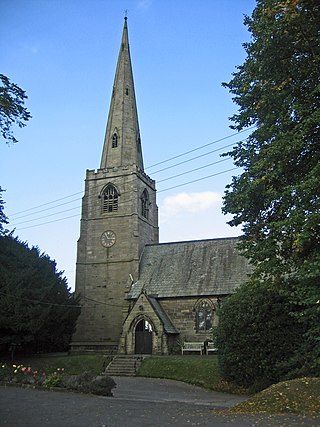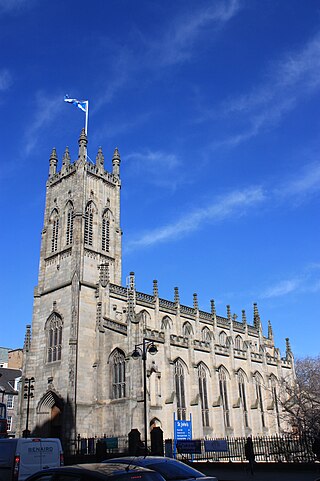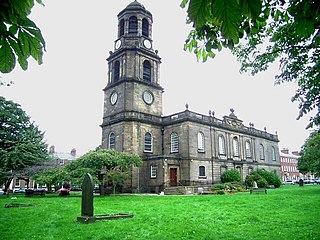
Paisley is a large town situated in the west central Lowlands of Scotland. Located north of the Gleniffer Braes, the town borders the city of Glasgow to the east, and straddles the banks of the White Cart Water, a tributary of the River Clyde.

St Giles' Cathedral, or the High Kirk of Edinburgh, is a parish church of the Church of Scotland in the Old Town of Edinburgh. The current building was begun in the 14th century and extended until the early 16th century; significant alterations were undertaken in the 19th and 20th centuries, including the addition of the Thistle Chapel. St Giles' is closely associated with many events and figures in Scottish history, including John Knox, who served as the church's minister after the Scottish Reformation.

The Basilica of St. Francis Xavier is a parish church in the Archdiocese of Dubuque located in Dyersville, Iowa, United States. The church was named in honor of the missionary Saint Francis Xavier. It was raised to the status of a minor basilica in 1956. The church and rectory were listed together on the National Register of Historic Places in 1999.

Paisley Abbey is a parish church of the Church of Scotland on the east bank of the White Cart Water in the centre of the town of Paisley, Renfrewshire, about 7 miles west of Glasgow, in Scotland. Its origins date from the 12th century, based on a former Cluniac monastery. Following the Reformation in the 16th century, it became a Church of Scotland parish kirk.

Coats Observatory is Scotland's oldest public observatory. It is currently closed for refurbishment as part of a 4-year long £42m transformation of the observatory and museum buildings. Located in Oakshaw Street West, Paisley, Renfrewshire, the observatory has been operational since 1 October 1883 and continues to function to this day, offering visitors the opportunity to view the night sky through the powerful telescopes housed within the building. The observatory is currently closed for redevelopment and is due to reopen in 2023.

The Parish Church of St Cuthbert is a parish church of the Church of Scotland in central Edinburgh. Probably founded in the 7th century, the church once covered an extensive parish around the burgh of Edinburgh. The church's current building was designed by Hippolyte Blanc and completed in 1894.

St John the Evangelist's Church is located to the north of the village of Ashton Hayes, Cheshire, England. It is an active Anglican parish church in the diocese of Chester, the archdeaconry of Chester and the deanery of Chester. The church is recorded in the National Heritage List for England as a designated Grade II listed building.

John Harper was a Scottish Baptist pastor who died in the sinking of the RMS Titanic in the North Atlantic Ocean.

The Church of St John the Evangelist is a Scottish Episcopal church in the centre of Edinburgh, Scotland. It is sited at the west end of Princes Street at its junction with Lothian Road, and is protected as a category A listed building.

St. Michael's Episcopal Church, Parish House and Rectory is a group of architecturally-significant religious buildings located at 200-216 North Mill Street in Birdsboro, Berks County, Pennsylvania. It was added to the U.S. National Register of Historic Places in 1982.
Thomas Coats (1809–1883) was a Scottish thread manufacturer.

The German Evangelical Lutheran Church of Charleston, South Carolina, was incorporated on December 3, 1840. Through usage and custom the Church is now known as St. Matthew's German Evangelical Lutheran Church or St. Matthew's Lutheran Church and is a member of the South Carolina Synod of the Evangelical Lutheran Church in America.

Stubbekøbing Church is located in Stubbekøbing some 18 km (11 mi) northeast of Nørre Alslev on the Danish island of Falster. The basilical nave was built of limestone in the Late Romanesque period. Choir and tower are of brick, the choir built in Early Gothic style, tower and the northern chapels in the 15th century in Late Gothic style. In addition to its Renaissance altarpiece and pulpit, it has a variety of old frescos and wall decorations (1300–1500).

St Matthew's Church in Paisley is notable for its Art Nouveau architecture by WD McLennan, and stained glass window by Robert Anning Bell.

St John the Baptist Church at Penshurst, Kent is a Grade I listed Anglican parish church in the Diocese of Rochester in England. Those buried or commemorated here include Knights, Earls, Viscounts, a Viceroy of India, a Governor-General of Australia, a Private Secretary to two Kings, two Field Marshals and two winners of the Victoria Cross. Through its courtiers, soldiers, statesmen, politicians or priests whose lives appear on memorials or through its changing architecture, brasses, carvings, effigies and windows, the church helps tell a country's story through the eyes of single village.

William James Morley FRIBA was an English architect who practised from offices in Bolton, Greater Manchester and Bradford, West Yorkshire.

Paisley Town Hall is a public hall in Abbey Close, Paisley, Renfrewshire, Scotland. The building, which is being converted into a centre for performing arts, is a Category A listed building.

The Church of Saint John the Baptist in Wakefield, West Yorkshire, England is an active Anglican parish church in the archdeaconry of Wakefield and the Diocese of Wakefield. The church is Grade II* listed and has been since 29 March 1971. St John's is the smaller of the Anglican churches in Wakefield City Centre, the larger being Wakefield Cathedral.

The Glencairn Aisle or Glencairn Vault at Kilmaurs, East Ayrshire is a Category B Listed vaulted sepulchral chapel built as a place for private contemplation and prayer that also contains a large memorial monument, as well as the burial crypt of the Cunningham Earls of Glencairn and their family members. An 'Aisle' is defined as a structure normally attached to a church, which may have burial crypt below, a family pew above, and sometimes a retiring room as at the Glencairn Aisle.



















